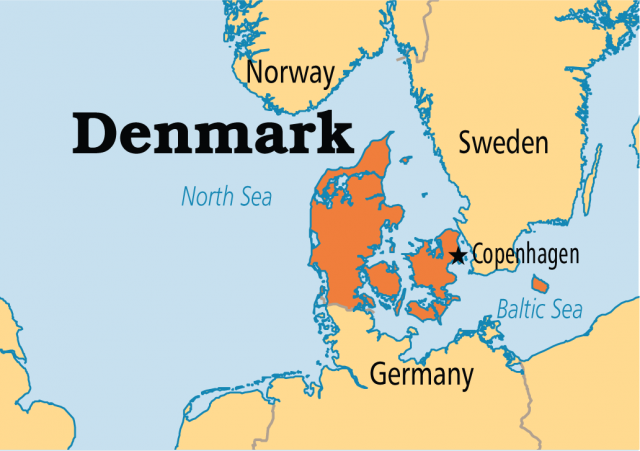Denmark
Area 16,807 square mi (43,094 square km)
Population 5.640 million 2014
Capital Copenhagen
Highest Point 571 ft (173 m)
Lowest Point -23 ft (-7 m)
GDP $342.0 billion 2014
Primary Natural Resources petroleum, natural gas, fish, salt.
DENMARK IS A COUNTRY whose history and culture is almost entirely shaped by the sea. With a coastline of 4,535 mi (7,314 km), nearly 500 islands, and numerous fjords and inlets, nowhere in Denmark is more than 31 mi (50 km) from the sea.
The Danes have traditionally played a role as a bridge between the language, culture, and politics of Central Europe and the Nordic nations of Scandinavia. Denmark is the smallest of the Nordic countries but has frequently been the dominant member, with the highest population and strongest economy.

Denmark consists of the peninsula of Jutland, connected to northern GERMANY through the province of Slesvig, plus the main island of Zealand (Sjaelland), which includes the capital of Copenhagen and nearly half the population and a number of smaller islands. Most of these islands are clustered in an archipelago to the east of Jutland, in the southwest corner of the Baltic Sea: Fyn, Lolland, Falster, and Mon. Other islands, generally long and thin, lie off the west coast. These are the northern Frisian islands, including Fano and Romo.
The island of Bornholm lies about 80 mi (130 km) to the east in the Baltic Sea, a relic of a time when Denmark's kings completely controlled the Baltic. This control was due to the strategic placement of Denmark along the narrow series of straits that connect the Baltic to the North Sea: the Skagerak, the Kattegat, and the Oresund. The Oresund in particular is only about 12.4 mi (20 km) wide, and until the 17th century, Denmark controlled both shores, effectively controlling all shipping access in and out of the Baltic Sea. Today, the eastern shore of the Oresund is part of SWEDEN, and since the completion of the monumental Oresund bridge and tunnel system in 1999, it has become more a connector between the two countries.
Jutland is almost entirely flat, particularly along the western coast, where dikes are necessary in some places to keep out the sea. Some areas in the center are hilly, but the average elevation is only 98 ft (30 m). Much of this landscape shows the effects of glaciation through several ice ages: morainic hills, moors, and downs.
Several fjords indent the peninsula, notably Flensborg Fjord, which divides Denmark from Germany, the Abenra and Vehle fjords of the eastern coast, and the Lim Fjord, which slices nearly all the way through the tip of northern Jutland—with the creation of the Thyboron Canal, this section of Jutland became, in fact, an island.
Denmark's largest city and major port is Copenhagen (population 1.4 million) on Zealand. Other major ports include Esbjerg, Alborg, and Arhus on Jutland. Other large cities are on the islands: Odense on Fyn (home of Hans Christian Andersen), Nykobing on Falster, and Roskilde and Frederiksberg on Zealand. Lacking significant raw materials, Denmark made use instead of its position as a seafaring nation to import, process, and re-export products, creating one of the most dynamic economies in Europe. Its commercial fleet is the third-largest in the world, and its standard of living is among the highest. Most of the country remains, nevertheless, a largely agricultural country, and some of Denmark's chief exports are meat and dairy, in addition to the more high-tech pharmaceuticals and electronics and the world-famous Lego toys. Denmark joined the EUROPEAN UNION in 1973 but has resisted full integration into the economic union, opting out of the common currency in 2000. The Kingdom of Denmark also includes GREENLAND and the FAEROE ISLANDS, both of which have developed near total autonomy in internal matters since the 1970s.